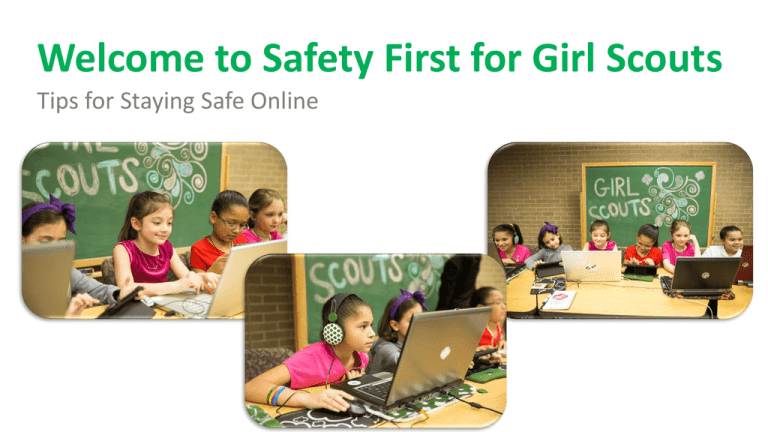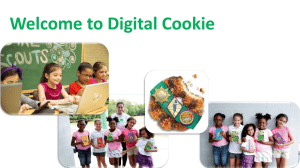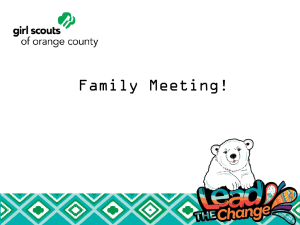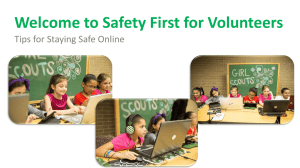Video Narration - GS University
advertisement

Welcome to Safety First for Girl Scouts Tips for Staying Safe Online What will you learn today? • • • • The right, safe way to use the Internet. Healthy Internet habits for Girl Scouts. How to follow a safe in-person cookie delivery plan. How to make sure you follow the Girl Scout safety guidelines – to keep your cookie sale fun! Using the Internet After watching this module, you’ll be able to: • Explain how the Internet works. • Describe why it’s so important to know who you are communicating with on the Internet. • Make an awesome Internet safety plan with a parent, troop leader, or adult volunteer. Why Is the Internet Important? Buy books, music, and clothes… Keep in touch with people… What Is the Internet? Homework Projects Play Games Skype with Grandma What Is a Browser? Programming language to create web pages. Software program to access the Internet. Internet Communication Be careful when communicating online: • You can only see their profile. • They might not be who is shown in a photo. • Tell an adult if you receive a message from a stranger. Communicate with people you know and trust. Making Your Own Internet Safety Plan Your Internet safety plan can include things like: • How to stay safe while communicating • How to stay safe while surfing the Web • How to stay safe while downloading files from the Internet • Adding protection software to your computer It’s Time to Check Your Progress Select the best answer: • What is the Internet? a. b. c. d. A programming language An email message A communication system A safety plan It’s Time to Check Your Progress Select the best answer: • An Internet safety plan should include: a. b. c. d. Downloading files Surfing the Web Communication All of the above Remember These Key Points! • The Internet can be super-fun, cool place that helps you do lots of important things. • It’s so important to communicate only with people you know and trust. • Tell an adult right away if you feel uncomfortable about anything you receive or see online. • Create an Internet safety plan with your parent, guardian, or troop leader. Using Social Sites After watching this module, you’ll be able to: • Identify social networking sites that are OK for your age. • Describe how to use social sites in a super-smart way. • Explain why it’s important to be careful about the stuff you share on social sites. So What Are Social Networking Sites? • Social networking sites help people find others who like the same things. • There are tons of social networking sites like Facebook, Twitter, Instagram, and Vine. How to Join a Social Networking Site • • • • Get permission from a parent/guardian to set up a social site account. Set up an account and profile. Find friends, classmates, and other users with similar interests. Posts can be text, images, videos, or even links to other websites. Protect Your Identity • Tips to follow when creating a user name and profile: – Use only your first name. – Include only general information about your location. – Do not include the name of your school. – Share only general likes, such as your favorite color, food, or type of music. Privacy Settings • Restrict people you don’t know from seeing your posts. • Require people to be approved by you before being able to connect with you. • Accept requests to connect only from people you know. Be Careful How Much You Share • • • • • Don’t post your vacation plans or when you’ll be away. Be nice – this is always a great rule! Don’t do or say anything that makes anyone feel uncomfortable. Don’t share any personal information. Don’t give out your birthdate. And if any post or connection request feels wrong, even in the smallest way, tell an adult right away! It’s Time To Check Your Progress Select the best answer: 1. What is the purpose of social networking sites? a. To spread rumors b. To connect people who like similar things c. To restrict access to information about others d. To provide new services to others 2. One way to protect your identity on social sites is to use only your first name. a. True b. False Remember These Key Points! • Protect your identity by setting up smart usernames and profiles. • Restrict access to the information on your social sites with Privacy Settings. • Don’t share information in your posts that makes it easy for people to learn too much about you. • If you feel uncomfortable online, tell an adult right away! Good Manners for the Internet After watching this module, you’ll be able to: • Explain the types of personal information and images that are safe and OK for the Internet. • Describe the kinds of words and details you can use while staying safe on the Internet. Personal Information • Hush, hush • Okay to Share This – First name – Council name – Last name – Phone number – Home address – Email address – School name – And most other things! Images and Videos Before uploading your images or videos, check that all of these things are true: • The image or video shows you behaving appropriately. • The image or video shows you wearing parentapproved clothes. • You have informed anyone else the image or video that you plan to upload it. • You have your parent or guardian’s permission. Other People’s Images and Videos • Get permission to use photos or videos of others. How to Use Your Words Online • What to do: – Be kind and respectful of others – Use proper rules of writing • What to avoid: – Angry words – Too many acronyms – All capital letters Remember These Key Points! • Having good Internet manners can make your experience online that much more fun. • Stay safe! • Keep your personal information private. • Take another look at the images and video checklist we showed you before uploading a photo or video. • Be kind, respectful, and careful when writing online. Knowing the Dangers After watching this module, you’ll be able to: • Explain some of the risks and threats of the Internet. People to Avoid • Online strangers • Cyberbullies What Is an Online Stranger? Anyone online whom you haven’t met in person. • Do not open email from online strangers. • Do not interact with them. • NEVER arrange a face-to-face meeting with an online stranger. What Is Cyberbullying? • Bullying that happens online – Mean or threatening messages. – Spreading lies about you. • This behavior could come from someone you know or someone who keeps their identity secret • If this happens, tell an adult right away! Inappropriate Images If you receive or come across any image or video that makes you feel embarrassed or uncomfortable: – Know that you do not have to look at it – Tell an adult right away – Do not share it or send it to others Online Theft • Avoid sharing personal information online. • When you do need to share personal information online, be aware of phishing scams. • Check your Internet settings to be sure that you are managing your browser’s cookies. It’s Time to Check Your Progress Select the best answer: • An online stranger is _________. a. b. c. d. someone you have met in person, but not online before someone you have not met in person before an email buddy a classmate that bullies you online It’s Time to Check Your Progress Select the best answer: • What does a cyberbully do? a. b. c. d. Spreads rumors. Threatens people. Sends mean messages. All of the above. Remember These Key Points! • Using the Internet to stay in touch with people is great – just stay alert to the dangers involved. • Remember the following key points: – Interact online only with people you know. – Tell a parent or guardian if you are contacted by an online stranger or if you think you are the victim of a cyberbully. – Tell a parent or another adult if you receive inappropriate images. – Protect yourself against online theft by not sharing personal information. Applying It All to Digital Cookie After watching this module, you’ll be able to: • Explain the details of the Girl Scout Internet Safety Pledge. • Apply what you know about Internet safety to Digital Cookie. Girl Scout Internet Safety Pledge You must agree to the following for online safety: • Do not give out personal information. • Never agree to an in-person meeting with someone you met online. • Follow the rules of each website. • Tell an adult if you see anything that makes you feel uncomfortable. Girl Scout Internet Safety Pledge (cont.) • Never send a person your picture or anything else without checking with a parent. • Talk with a parent about setting up rules for using the Internet. • Follow the safety rules of Digital Cookie from the Girl Scout Cookie Program. Girl Scout Internet Safety Pledge (cont.) • Practice good manners online, including: – Not spamming others – Not bullying others – Not tolerating bullying – Not using bad language • I will be guided by the Girl Scout Promise and Law. Review Girl Scout Safety Policies and the Digital Cookie Safety Pledge • Computer/Online Use: Safety Activity Checkpoints • Girl Scout Cookie/Council-Sponsored Product Safety Checkpoints Applying It All to Digital Cookie Marketing in the Digital Cookie Site • When marketing your Digital Cookie site, remember the following Internet safety rules: – Communicate only with people you know. – Do not share your personal information. Photos and Videos in the Digital Cookie Site When setting up your customer-facing page, remember the following Internet safety rules: • Use only appropriate photos and videos • Use proper words It’s Time to Check Your Progress Select the best answer: 1. What personal information is okay to give out online? a. b. c. d. First name Last name Home address Cell phone number 2. Internet safety rules apply to Digital Cookie even though you have to log in to the site to use it. a. True b. False Remember These Key Points! • Review all the Internet safety information available. • Remember the Internet safety rules when working with Digital Cookie. • And don’t forget to have lots of safe, awesome fun! Girl Scout Safety Resources and Planning After watching this module, you’ll be able to: • Adhere to rules documented within the Girl Scout Safety resources. • Develop an in-person cookie delivery plan using the Girl Scout safety resources. Rules for Girl Scout Safety You can find more Girl Scout rules and guidelines within the following documents: • Safety Activity Checkpoint “Girl Scout Cookie/Council Sponsored Product Sale” document. • Safety Activity Checkpoint “Computer/Online Use” document. Develop a Plan for In-Person Cookie Delivery • All Girl Scouts should use the tips and guidelines in the safety resource documentation to develop a safety plan for in-person cookie delivery. • This can be done with a parent/caregiver or a troop leader. • The safety plan should contain information regarding neighborhood, storefront, and any other in-person cookie delivery methods. Why Is a Plan Important? A plan of safety is essential for in-person cookie sales because: • It defines the safety rules for in-person cookie sales. • It helps ensure the physical safety of the Girl Scout participating in the Girl Scout Cookie Program. • It helps protect the privacy of the Girl Scout. • It informs everyone of the rules that are to be followed. Thanks for watching, and remember… • Become familiar with the Girl Scout Safety Checkpoint documents. • Create a safety plan with parents/caregivers or troop leaders. Thank You for Watching! • You have now completed the Safety First tutorial and we hope you found the information helpful. • You will find more tutorials within Digital Cookie. • Thank you for joining us to keep Girl Scouts safe!








